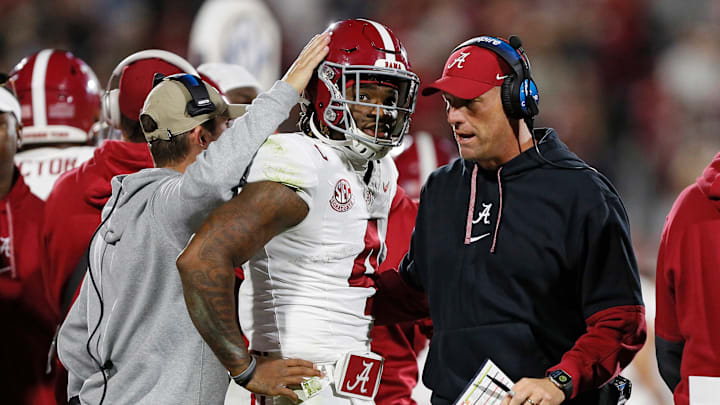“I have people in my room asking, why are we still in the NCAA.”
I'm sorry? What.
Greg Sankey, commissioner of the Southeastern Conference, seems to be under the impression that dominance surrounding the conference itself still exists.
Still.
He must be mistaken. Because this no longer feels like the old SEC. The era of Southern supremacy and untamed dominion over the rest of the NCAA pool might finally be slipping. And if Sankey’s remarks are any indication. He might be the last to realize it…
The SEC held the reins for a very long time. Since 2000, the Southeastern Conference has taken ownership of 15 national championships. This run falls nothing short of dominant. Far too often, the likes of Alabama, Georgia, LSU, and Florida have haunted opponents.
It wasn’t until last season that the SEC took a notable decline. In the wake of the newly designed 12-team Playoff, four SEC teams reached the bracket, and not one of them made it to the national championship.
That's a pretty high standard. By all means, yes, it is. However, this is the bar the conference set for itself after Alabama won six titles since 2009, and Georgia went back-to-back in 2021 and 2022. And that was the last time they did it. Fairly recently, but still, not good enough. In those short two years, the Big Ten’s Michigan Wolverines and Ohio State Buckeyes brought two championships home.
In this new era of recruitment and NIL, other programs have begun to ascend. For the first time since 2014, Notre Dame made it onto the title stage. Additionally, programs outside of the Power 4 are receiving increased opportunities to make the Playoffs. Teams such as Boise State notched a spot over Alabama simply because of its stronger resume.
The rapid changes have called for adaptation. If you can’t see behind the lines, it's quickly becoming a juggernaut system between the SEC and Big Ten. Last year, the SEC added both Texas and Oklahoma from the Big 12. Likewise, the Big Ten effectively dismantled the PAC-12 with the additions of Oregon, UCLA, Washington, and USC.
This completely unorthodox conference realignment has given more power to the conferences outside of the SEC. The Big Ten saw one of its most successful years in recent history, even with the disappointment of Michigan. Why? Because the conference no longer holds regional coverage, it has expanded vastly. Even in a down year for UCLA, Washington, and USC, those eyes were still brought to the screen, largely because of the newfound conference rivalries. Who doesn’t want to watch the Big Ten on CBS for a 3:30 afternoon game?
The connotation that the SEC has the toughest opponents is starting to fade. Of course, the schedule that Florida played this past year was astounding. However, the SEC typically produces bulldozers, and I’m not sure if you could point to one from last season. You could absolutely point to the fact that Nick Saban is gone. You can blame NIL. You can make excuses for conference realignment. In the end, it was a down year for these “juggernauts” that the conference has become prone to having.
Most of all, the idea that you can make the playoffs just simply because you are in the SEC is laughable. Alabama finished with a 9-4 record and topped their disappointing season with a closing bowl game loss to Michigan. South Carolina took to a 9-4 record to lose to Illinois in the Citrus Bowl. Texas A&M lost to USC in the Las Vegas Bowl, and to make it worse, both Tennessee and Georgia lost their lone games in the Playoff.
A particle reason for this all-around lack of winning revolves around the overhype. The AP and CFP committee has traditionally favored the SEC when it came time to select bowl games and “Who’s In.” Although, it took a turn this year as Alabama, Ole Miss, and South Carolina were controversially left out in favor of SMU, who lost in the ACC Championship to Clemson. Ultimately, these teams fell short because of the team’s inexcusable losses. For example, Alabama’s resume included losses to Vanderbilt and Oklahoma late in the season.
When it comes to SEC football, we tend to zone in on Alabama. But it wasn’t just the Tide that fell short in this way. Ole Miss had very high expectations coming into the 2024 season, which were shot down in a loss at home to Kentucky, as well as losses to Florida and LSU. The theme isn’t just Alabama, it’s the SEC, in general.
Of course, the landscape of college athletics is still changing. Presumably, this new era, has hurt the Southeastern Conference more than any other. The way we stand right now, there is an even playing field for every team. No longer does the SEC have prestige media-televison rights. No longer does the SEC have premier developmental pipelines, and worst of all, no longer does the conference hold authority.
For years, the conference ran all things college football, and in hindsight, that rampage is coming to a halt. In all fairness, the SEC is going to remain competitive for years to come. The addition of the Texas Longhorns might go down as one of the best additions to any conference in CFB history.
As the self-aggrandizement continues to set in, and an unknown future lies ahead, where will the SEC be in the years to come? One could only hope the conference will remain in the NCAA…that is, if they aren’t too good for it.
